Determination of prevalence and antimicrobial sensitivity pattern of extended spectrum beta-lactamase producing Enterobacteriaceae from various clinical specimens in Medinah during Hajj
Al-ahmadey ZiabMicrobiology Research International
Published: April 24 2020
Volume 8, Issue 2
Pages 29-34
DOI: https://doi.org/10.30918/MRI.82.20.012
Abstract
The spread of extended spectrum beta lactamase (ESBL) producing Enterobacteriaceae has dramatically increased and become a major public health concern worldwide. The main purpose of the study was to determine antibiotic resistance patterns among ESBL producing Enterobacteriaceae isolated from clinical specimen of pilgrims during Hajj in Medinah, Saudi Arabia. A total of 69 consecutive non-duplicate isolate Enterobacteriaceae were examined by cultured in selective and non-selective media, therefore between June and august 2019. All isolates were identified and tested for susceptibility by the VITAK II. Detection of ESBL was carried out by double disk synergy test technique. Of 69 of Enterobacteriaceae isolates, 3 isolates were associated with multidrug resistance (MDR) phenotype. All isolates showed variable resistance levels to all antibiotics used here expect to colistin, where they were all colistin-sensitive. Sensitivity of 98% was observed to amikacin. 12 out of 69 E. coli isolates were positive for ESBLs by phenotypic methods. 16 out of 69 Klebsiella pneumoniae isolated were ESBL producers. Most of the ESBLs were from urine (45%). The main risk factors for ESBL in these children were previous exposure to antimicrobials and prolonged hospital stay and female gender (68%). No resistance was recorded for the following combinations of antibiotic: amikacin plus nitrofurantoin, amikacin plus piperacillin-tazobactam. Carbapenems are the most sensitive and reliable treatment options for infections caused by ESBL producing Enterobacteriaceae. Amikacin plus piperacillin-tazobactam are good alternatives. Our study documented the high antimicrobial resistance of ESBL producing Enterobacteriaceae to many first line antibiotics currently used to treatment patients, and this implies the need to continuously revise the local guidelines used for optimal empirical therapy for patients.
Keywords: ESBL, Enterobacteriaceae, antibiotic resistance.
Full Text PDF
